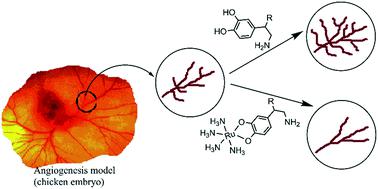当前位置:
X-MOL 学术
›
RSC Med. Chem.
›
论文详情
Our official English website, www.x-mol.net, welcomes your feedback! (Note: you will need to create a separate account there.)
Vascular tone and angiogenesis modulation by catecholamine coordinated to ruthenium
RSC Medicinal Chemistry ( IF 4.1 ) Pub Date : 2020-02-27 , DOI: 10.1039/c9md00573k Jacqueline Querino Alves 1, 2, 3, 4, 5 , Laena Pernomian 4, 5, 6, 7 , Cássia Dias Silva 1, 2, 3, 4, 5 , Mayara Santos Gomes 4, 5, 6, 7 , Ana Maria de Oliveira 4, 5, 6, 7 , Roberto Santana da Silva 1, 2, 3, 4, 5
RSC Medicinal Chemistry ( IF 4.1 ) Pub Date : 2020-02-27 , DOI: 10.1039/c9md00573k Jacqueline Querino Alves 1, 2, 3, 4, 5 , Laena Pernomian 4, 5, 6, 7 , Cássia Dias Silva 1, 2, 3, 4, 5 , Mayara Santos Gomes 4, 5, 6, 7 , Ana Maria de Oliveira 4, 5, 6, 7 , Roberto Santana da Silva 1, 2, 3, 4, 5
Affiliation

|
Catecholamines participate in angiogenesis, an important tumor development process. However, the way catecholamines interact with their receptors has not been completely elucidated, and doubts still remain as to whether these interactions occur between catechol and/or amine sites and particular amino acid residues on the catecholamine receptors. To evaluate how catechol and amine groups contribute to angiogenesis, we immobilized the catechol site through ruthenium ion (Ru) coordination, to obtain species with the general formula [Ru(NH3)4(catecholamine-R)]Cl. We then assessed the angiogenic activity of the complexes in a chorioallantoic membrane model (CAM) and examined vascular reactivity and calcium mobilization in rat aortas and vascular cells. [Ru(NH3)4(catecholamine-R)]Cl acted as partial agonists and/or antagonists of their respective receptors and induced calcium mobilization. [Ru(NH3)4(isoproterenol)]+ [Ru(NH3)4(noradrenaline)]+, and [Ru(NH3)4(adrenaline)]+ behaved as antiangiogenic complexes, whereas [Ru(NH3)4(dopamine)]+ proved to be a proangiogenic complex. In conclusion, catecholamines and [Ru(NH3)4(catecholamine-R)]Cl can modulate angiogenesis, and catechol group availability can modify the way these complexes impact the vascular tone, suggesting that catecholamines and their receptors interact differently after catecholamine coordination to ruthenium.
中文翻译:

儿茶酚胺与钌配合调节血管张力和血管生成
儿茶酚胺参与血管生成,这是重要的肿瘤发展过程。然而,尚未完全阐明儿茶酚胺与其受体相互作用的方式,并且仍然怀疑这些相互作用是否在儿茶酚和/或胺位点与儿茶酚胺受体上的特定氨基酸残基之间发生。为了评估邻苯二酚和胺基团如何促进血管生成,我们通过钌离子(Ru)配位固定了邻苯二酚位点,从而获得了具有通式[Ru(NH 3)4(儿茶酚胺-R)] Cl的物质。然后,我们评估了脉络膜尿囊膜模型(CAM)中复合物的血管生成活性,并检查了大鼠主动脉和血管细胞中的血管反应性和钙动员。[Ru(NH 3)4(儿茶酚胺-R)] Cl充当其各自受体的部分激动剂和/或拮抗剂并诱导钙动员。[Ru(NH 3) 4(异丙肾上腺素)] + [Ru(NH 3) 4(去甲肾上腺素)] +和[Ru(NH 3) 4(肾上腺素)] +表现为抗血管生成复合物,而[Ru(NH 3) 4(多巴胺)] +被证明是促血管生成的复合物。总之,儿茶酚胺和[Ru(NH 3) 4(儿茶酚胺-R)] Cl可以调节血管生成,而儿茶酚基团的可用性可以改变这些复合物影响血管张力的方式,表明儿茶酚胺及其受体与钌配位后相互作用不同。
更新日期:2020-02-27
中文翻译:

儿茶酚胺与钌配合调节血管张力和血管生成
儿茶酚胺参与血管生成,这是重要的肿瘤发展过程。然而,尚未完全阐明儿茶酚胺与其受体相互作用的方式,并且仍然怀疑这些相互作用是否在儿茶酚和/或胺位点与儿茶酚胺受体上的特定氨基酸残基之间发生。为了评估邻苯二酚和胺基团如何促进血管生成,我们通过钌离子(Ru)配位固定了邻苯二酚位点,从而获得了具有通式[Ru(NH 3)4(儿茶酚胺-R)] Cl的物质。然后,我们评估了脉络膜尿囊膜模型(CAM)中复合物的血管生成活性,并检查了大鼠主动脉和血管细胞中的血管反应性和钙动员。[Ru(NH 3)4(儿茶酚胺-R)] Cl充当其各自受体的部分激动剂和/或拮抗剂并诱导钙动员。[Ru(NH 3) 4(异丙肾上腺素)] + [Ru(NH 3) 4(去甲肾上腺素)] +和[Ru(NH 3) 4(肾上腺素)] +表现为抗血管生成复合物,而[Ru(NH 3) 4(多巴胺)] +被证明是促血管生成的复合物。总之,儿茶酚胺和[Ru(NH 3) 4(儿茶酚胺-R)] Cl可以调节血管生成,而儿茶酚基团的可用性可以改变这些复合物影响血管张力的方式,表明儿茶酚胺及其受体与钌配位后相互作用不同。


























 京公网安备 11010802027423号
京公网安备 11010802027423号